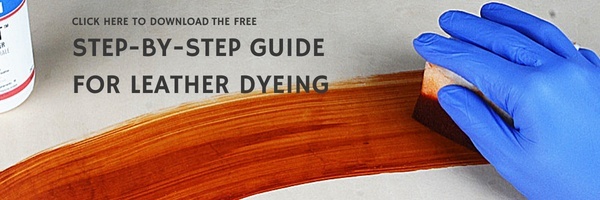A very popular leather dye among leather crafters consists in alcohol mixed with coloring substances: a simple and generally quite economical formulation. One of the most popular is Fiebing's leather dye.
Alcohol-Based Dye is widespread because it has a good penetration of leather. Once penetrated into the leather, it carries the coloring substances with it, then the alcohol evaporates leaving the coloring substances inside the leather fibers.
As the alcohol evaporation point is much lower than water, the drying process is quite rapid compared to water based products. Alcohol-based leather dyes, however, do not have a good level of impregnation of the leather fibers, which is why very often leather items that have been colored with this type of leather dye have problems of color rub-off.
Moreover, since the drying phase is very rapid, the alcohol that evaporates tends to drag with it a part of the residual moisture of the leather, thus modifying the characteristics of softness, and very often drying the leather and making it stiffer.
So we can resume the features of an alcohol-based leather dye:
- Rapid penetration
- Quick drying
- Strong and pungent smell
- Low level of fiber impregnation
- Tendency to dry the skin
Until recently, alcohol-based or solvent-based dyes were the only ones available on the market, as chemical technology did not provide alternatives for the craft coloring of leather. About ten years ago it has begun to appear the first water-based dye, or dyes where the presence of alcohol or solvents in the mixture were in such low percentages that could be defined as water based.
Contrary to alcohol-based dyes, the water-based dyes are made of a more complex mixture: usually in the formulation they include a resin (or a mixture of resins of acrylic or polyurethane origin): the resin guarantee the impregnation of the leather fibers and the coupling of the coloring substances to them. Moreover, in the formulation may be present additional components such as wax, grease or oils necessary for maintaining the softness of the leather or to increase some characteristics such as polishing.
The penetration of water-based leather dye is therefore more difficult and the drying time is slower than the alcohol based, but on the other hand this allows you to have a greater color bonding and maintaining the original softness of the leather.
To resume the main features of a water-based leather dye:
- Slow penetration
- Slow drying
- No Smell
- Good color consistency
- Good resistance to color rub-off
- Maintaining of original leather softness
The choice of leather dye depends on multiple factors, such as the type of leather you should dye, the finish effect you want to achieve, ecc.



